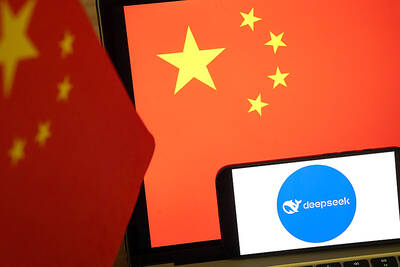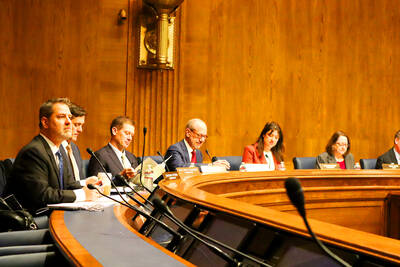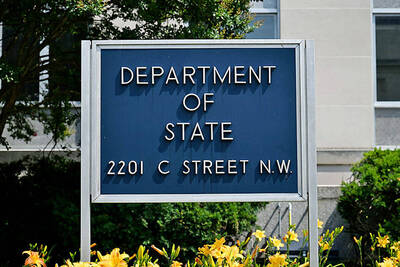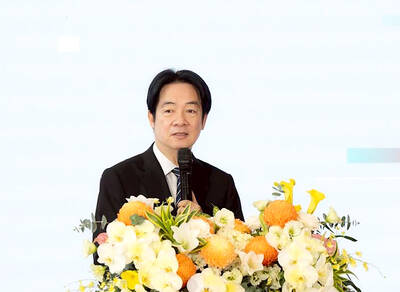China yesterday condemned North Korea’s launch of an intercontinental ballistic missile and urged restraint by all sides after the US and South Korea held a military exercise in response to the test.
“China opposes North Korea’s violations of UN Security Council resolutions and [its actions] contrary to the general aspirations of the international community,” Chinese Ministry of Foreign Affairs spokesman Geng Shuang (耿爽) said.
Beijing “urged North Korea to abide by UN resolutions and stop taking actions that could worsen the situation,” Geng said in a brief statement on the ministry’s Web site.
“At the same time, [China] hopes that all parties concerned will exercise caution and avoid aggravating tensions and act together to preserve peace and stability on the peninsula,” he added.
Washington, Tokyo, Seoul and the EU all swiftly condemned Friday’s missile test.
The US and South Korea conducted a live-fire exercise using surface-to-surface missiles after the launch, the US Army said.
The heads of the US and South Korean militaries discussed “military response options” after North Korea’s launch, the Pentagon said.
China, Pyongyang’s main economic and diplomatic ally, opposes any military intervention and has called for a resolution through dialogue.
The test has prompted the South to speed up the deployment of a US missile defense system, South Korean Minister of National Defense Song Young-moo said.
The US military would also roll out “strategic assets” in the South in response to the test, he said, without providing further details.
Strategic assets normally refer to high-profile weapons systems, such as stealth bombers and aircraft carriers.
Parts of the Terminal High Altitude Area Defense (THAAD) system were transported to the country under the government of former South Korean president Park Geun-hye, but new South Korean President Moon Jae-in last month suspended deployment, citing the need for a new environmental impact assessment.
“We will soon start consultations on the tentative deployment” of the remaining components of the THAAD battery in response to Pyongyang’s most recent test, Song told journalists.
The THAAD battery is composed of six interceptor missile launchers. Two launchers have been tentatively deployed at a golf course-turned-US military base in Seongju County, about 300km south of Seoul.
A senior official at South Korea’s presidential Blue House said Seoul had also informed Beijing of the decision.
The THAAD deployment has infuriated China, which has argued that it will destabilize the region.
The South Korean Ministry of National Defense also released a video of a newly developed ballistic missile, which it said was one of the world’s “most accurate and powerful” weapons and capable of striking “any target in the North at any time and any place.”

MISINFORMATION: The generated content tends to adopt China’s official stance, such as ‘Taiwan is currently governed by the Chinese central government,’ the NSB said Five China-developed artificial intelligence (AI) language models exhibit cybersecurity risks and content biases, an inspection conducted by the National Security Bureau (NSB) showed. The five AI tools are: DeepSeek, Doubao (豆包), Yiyan (文心一言), Tongyi (通義千問) and Yuanbao (騰訊元寶), the bureau said, advising people to remain vigilant to protect personal data privacy and corporate business secrets. The NSB said it, in accordance with the National Intelligence Services Act (國家情報工作法), has reviewed international cybersecurity reports and intelligence, and coordinated with the Ministry of Justice Investigation Bureau and the National Police Agency’s Criminal Investigation Bureau to conduct an inspection of China-made AI language

LIMITS: While China increases military pressure on Taiwan and expands its use of cognitive warfare, it is unwilling to target tech supply chains, the report said US and Taiwan military officials have warned that the Chinese People’s Liberation Army (PLA) could implement a blockade within “a matter of hours” and need only “minimal conversion time” prior to an attack on Taiwan, a report released on Tuesday by the US Senate’s China Economic and Security Review Commission said. “While there is no indication that China is planning an imminent attack, the United States and its allies and partners can no longer assume that a Taiwan contingency is a distant possibility for which they would have ample time to prepare,” it said. The commission made the comments in its annual

CHECKING BOUNDARIES: China wants to disrupt solidarity among democracies and test their red lines, but it is instead pushing nations to become more united, an expert said The US Department of State on Friday expressed deep concern over a Chinese public security agency’s investigation into Legislator Puma Shen (沈伯洋) for “secession.” “China’s actions threaten free speech and erode norms that have underpinned the cross-strait ‘status quo’ for decades,” a US Department of State spokesperson said. The Chongqing Municipal Public Security Bureau late last month listed Shen as “wanted” and launched an investigation into alleged “secession-related” criminal activities, including his founding of the Kuma Academy, a civil defense organization that prepares people for an invasion by China. The spokesperson said that the US was “deeply concerned” about the bureau investigating Shen

‘TROUBLEMAKER’: Most countries believe that it is China — rather than Taiwan — that is undermining regional peace and stability with its coercive tactics, the president said China should restrain itself and refrain from being a troublemaker that sabotages peace and stability in the Indo-Pacific region, President William Lai (賴清德) said yesterday. Lai made the remarks after China Coast Guard vessels sailed into disputed waters off the Senkaku Islands — known as the Diaoyutai Islands (釣魚台) in Taiwan — following a remark Japanese Prime Minister Sanae Takaichi made regarding Taiwan. Takaichi during a parliamentary session on Nov. 7 said that a “Taiwan contingency” involving a Chinese naval blockade could qualify as a “survival-threatening situation” for Japan, and trigger Tokyo’s deployment of its military for defense. Asked about the escalating tensions